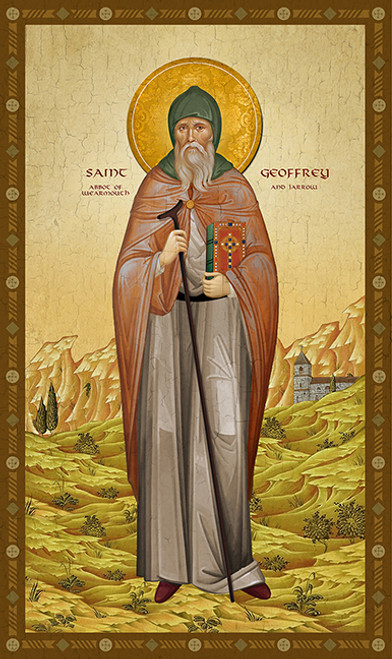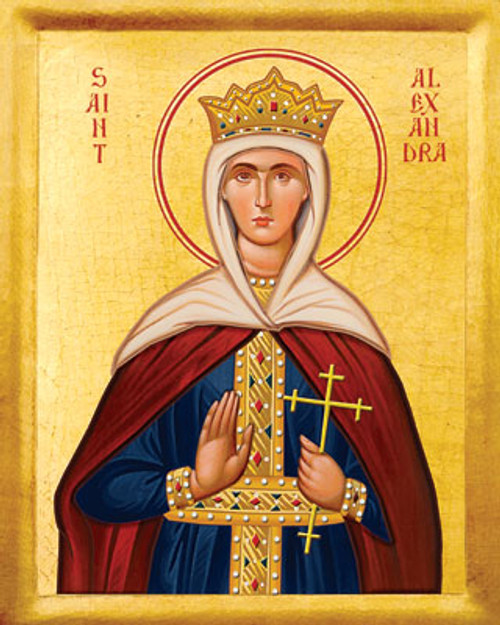Commemorated September 25
In the Orthodox Church today we venerate Ceolfrið [or Geoffrey], the third abbot of the double monastery at Wearmouth and Jarrow, successor to Saint Biscop as the abbot of St Paul’s in Jarrow in 681 and successor to Abbot Sigefrið at St Peter’s in Wearmouth in 690. Ceolfrið was also the spiritual father and mentor to Holy Bede, the venerable historian of the English Church.
Saint Ceolfrið, born about 642 and probably a native Northumbrian, was one of Venerable Biscop’s close friends and monastic disciples. He aided in the founding of the monastery at Monkwearmouth in 674, and accompanied Biscop on one of his farings to Rome in 678, ‘for the sake of acquiring instruction, and offering up his prayers’. In 681, Saint Biscop entrusted the thirty-nine-year-old monk with the rule over the abbey at Jarrow, where at once he began to prove himself a capable administrator and a zealous servant of God – a worthy successor to the Benedict of the North. He doubled the volume of the already-large libraries of the two monasteries which his predecessor had started, and he increased the number of monks between the two to six hundred. He had gifted to each monastery a complete edition of the Vulgate Bible; built several oratories in the monastery; and greatly increased the sacred vessels and vestments. He also obtained by charter from the hands of the half-Irish Ealdferð King of Northumbria a tract of land near the river Fresca, which was later traded for another sizeable tract, contiguous to (and half the size of the original lands of) Jarrow, at Sambuce. He also purchased another estate for Jarrow at Dalton. Another charter he sent several brothers for from Rome, guaranteed and renewed the privileges the monastery had enjoyed under Saint Biscop.
Saint Ceolfrið was abbot over both monasteries for twenty-six years. Under Ceolfrið, the abbey school – enriched by his additions to the sizeable library – became a beacon of learning in both Greek and Latin, and this learning was something of which Saint Bede absolutely availed himself. In 701, Saint Sergius I, the Syrian-born Pope of Rome, even bade Ceolfrið send one of the monks from his school to advise him on certain ecclesiastical problems. Consider: in the space of just over a hundred years, England went from being a heathen backwater and the site of a fierce missionary struggle, to providing the Pope with advisers on churchly matters! Saint Ceolfrið’s erudition is also clearly shown in his epistle to Naitan, King of the Picts. This letter was preserved in its entirety by his pupil Bede. It accompanied the gift of the service of several monastic architects from Jarrow who would assist the king in building a stone church after the Roman style, and its contents touched on the matter of the calendar which had divided the Celtic from the English Church for so long, as well as on the proper tonsure for monks. The language of this letter clearly marks out Abbot Ceolfrið as one of the preëminent scholarly minds and most talented of prosaists of his age in the British Isles.
In addition, Bede describes his teacher and master as a man of immense talent and gifted also with intense zeal. He was a peerless chanter and showed great diligence in saying the daily prayers. Though he was strict with himself and with offenders among the monks, he was known to show mercy and clemency upon the younger brothers, the elderly and those who could not bear harsh austerities. He was modest in his dress and kept a strict fast.
As old age and infirmity came upon the wise monk, Ceolfrið found the duties of running two monasteries at once were becoming onerous, and did due diligence in announcing his resignation. Saint Bede recounts that his master feared that in his old age, his capacity for impressing upon the brethren by both his personal example and by direct instruction the spiritual warfare necessary to a monk’s life. Abbot Ceolfrið then declared his intention of returning to Rome, which once he had visited with Biscop. It was there he wished to end his life; and moreover he wished not to be burdened down with any debts in a country where he was well-known and beloved. Even though all six hundred of the monks of Wearmouth and Jarrow entreated him with tears not to go, nothing could dissuade him.
On the day of his departure, Ceolfrið celebrated the Divine Liturgy in the Church of St Peter, gave the Gifts and broke bread with those present. All the monks of Wearmouth and some of those from Jarrow assembled in the former place, and Abbot Ceolfrið lit the incense there for the last time and gave his benediction. They left the chapel and the beloved abbot said his farewells from the oratory of Saint Laurence in the dormitory standing across. He admonished the monks to adhere to the precepts of Biscop and of himself, and to continue always in the love of brother in which they had been taught. He forgave all of the monks there who had ever done wrong, and begged their own forgiveness of him in return if he had ever been overly-strict in his running of the monastery. The whole of the company processed down to the banks of the River Wear in sad solemnity, the litanies they sung being sometimes choked with loud sobs. He gave each of the monks personally the kiss of peace, crossed the river and venerated the Cross on the other side, then made his way to the Humber on horseback – where he would take a ship to Rome. He was delayed there some time, which allowed his successor Abbot Hwætberht to present himself in person to the former, and receive both his blessing and that of Bishop Saint Acca.
He found his way to Langres in Francia, where the elderly monk reposed at the age of seventy-four, on the twenty-fifth of September, 716. To the very end, he had kept to the full the rules of prayer and fasting to which he had been accustomed, notwithstanding his advanced years, his bodily infirmity or the exigencies of his journey. On only four days he did not hold the Liturgy – once when he was at sea, and three as he lay dying. He was buried in the monastery of the Twin Martyrs located about a mile south of the town, and his companions returned thereupon to England to relate his final days and hours. Some time afterward, his holy relics were translated from Langres to Wearmouth; on the approach of the heathen Danes, they were again moved, along with those of Holy Mother Hild, to Glastonbury. Venerable Ceolfrið, most learnèd and holy father of monks, pray unto Christ our God for our souls’ salvation!
Rejoice, Christians of Northumbria, for the Lord
Hath brought forth a holy one from your midst.
He tended monasticism and learning as a precious vine,
Bearing abundant fruit to the glory of God.
Now that the name of Saint Ceolfrið is inscribed in the Book of Life,
Pray with us that he may intercede for us all.
Exact Dimensions:
Small ~ 3.6x6”
Large ~ 5.9x10”
X-Large ~ 10x17”
Please contact us for larger sizes.







